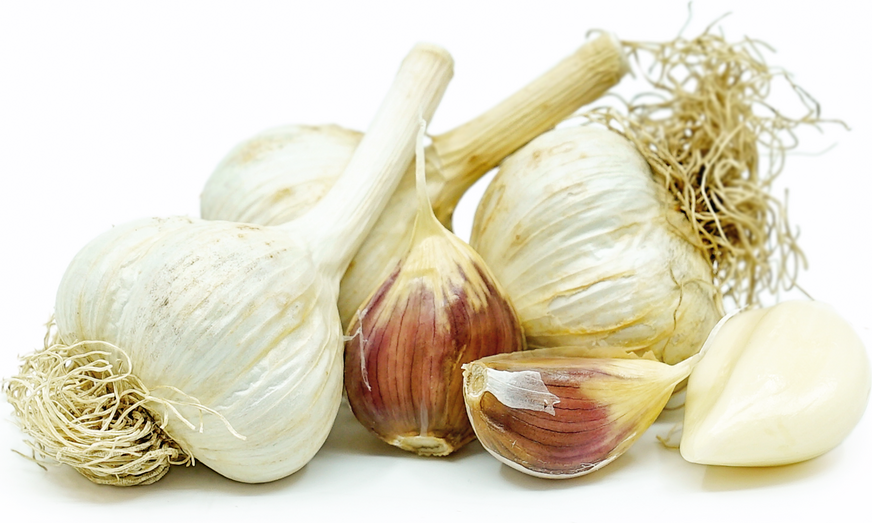


Bavarian Purple Garlic
Estimated Inventory, lb : 0
Description/Taste
Bavarian Purple garlic is a small to medium sized bulb that has a globular, tear-drop shape with 6-11 large, uniform cloves arranged around a central stalk. The outside of the bulb is covered in a thin, white papery coating that is loosely attached to a hard, purple-brown skin covering the cloves. The skin encasing the cloves is easy-to-peel, revealing cream-colored flesh that is firm, fragrant, and round in shape. Bavarian Purple garlic has a pungent, sweet, and earthy flavor with a mild heat that builds and quickly dissipates without becoming overbearing.
Seasons/Availability
Bavarian Purple garlic is typically harvested in the summer and available through the winter.
Current Facts
Bavarian Purple garlic, botanically classified as Allium sativum var. ophioscorodon, are the taproots of leafy stalks that grow 60-91 centimeters in height and belong to the Amaryllidaceae family. Considered a rocambole variety, Bavarian Purple garlic is a hardneck garlic which means the cloves grow in a single layer around a stalk that hardens when dried. The stalk also has a distinct shape that forms a double coil as it matures on the plant. Bavarian Purple garlic is known for its complex, pungent flavor and grows well in cool climates, often cultivated in home gardens by garlic enthusiasts as a well-rounded, everyday use variety.
Nutritional Value
Bavarian Purple garlic contains calcium, phosphorus, manganese, and vitamins B6 and C.
Applications
Bavarian Purple garlic has a mildly pungent flavor and is exceptionally versatile, utilized in both raw and cooked applications such as roasting and sautéing. When used fresh, the cloves can be thinly sliced and mixed into sauces such as aioli or pesto, hummus, tzatziki, salad dressings, and salsas. When cooked, the pungent heat lightly subsides as the garlic taste deepens with a rich, complex flavor. Bavarian Purple garlic can be roasted with vegetables, sautéed into stir-fries, mixed into pasta, or roasted with meats. It can also be blended into mashed potatoes, cooked into stews and soup, pickled for extended use, or dried and ground into powder as a flavoring. In addition to the cloves, the scapes can be lightly sautéed or cooked into stir-fries. Bavarian Purple garlic pairs well with tomatoes, potatoes, roasted meats including beef, pork, and poultry, herbs such as oregano, basil, thyme, and coriander, onions, spinach, and eggplants. The bulbs have a short shelf life and will keep 3-6 months when stored in a cool, dry, and dark place.
Ethnic/Cultural Info
Bavarian Purple garlic is considered a rocambole variety that is highly favored by garlic enthusiasts in the United States. Though garlic has been cultivated since ancient times, it wasn’t until 1989 that the United States was able to gather samples of many specialty garlic varieties located in the Caucasus region of Central Asia. Once protected by the Soviet Union, the USDA was prohibited from visiting the Caucasus region due to its proximity to Russian military bases. As the Soviet Union collapsed in 1989, the USDA was finally invited to gather garlic varieties. The American scientists had to travel at night with armed guards along the old silk road, and as they gathered the garlic, they named the varieties after the region they were obtained from. Many of the specialty varieties that are grown and loved by American garlic enthusiasts today were gathered and cultivated from this trip.
Geography/History
Garlic is native to Central Asia, specifically the region of the Caucasus mountain range, which is now modern-day Georgia and Russia, and was spread in all directions across Europe and Asia via trade routes and migrating peoples. The origins of Bavarian Purple garlic are mostly unknown, but one belief claims that the variety was developed in northern Europe and was introduced throughout the rest of Europe and to the United States via German, Polish, and Italian immigrants. Another belief is the variety was gathered during the USDA’s expedition in 1989. Today Bavarian Purple garlic is cultivated on a small scale and is available through local growers in Europe, Asia, and the United States.




